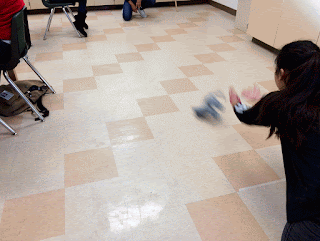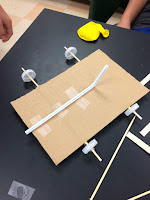Looking back at the first assessment for this unit, I wanted to note some of the variety of topics I got from my students. I was generally happy with the range of questions because the variety of topics for the paper itself ultimately cover topics from our whole year of standards.
Note: Not all are well written questions, these just just my quick notes as I went around to approve questions/topics so in some cases I greatly simplified the question to note the topic. For some others where the students picked more closed type questions I discussed with the student what they would need to investigate beyond the initial question to make the question rigorous enough. The questions also reflect student ability, my desire was for all students to be able to tackle this assessment, at least through the research and thinking maps. Questions like, “What is a meteor?” would be appropriate for some of my students, but too straight forwards for others.
Asteroids Details:
What causes an asteroids to burn up before it reaches the surface?
What are asteroids?
Examples of asteroids that threaten us?
How do we classify asteroids?
Where did the debris that formed asteroids come from?
Difference between an asteroid and a meteor?
What benefits and nonbenefits do asteroids give us?
How do asteroids come into the solar system?
Difference between an asteroids and a comet?
What are asteroids made of?
What is a meteor?
How often do asteroids hit the moon and what is the effect?
How to they enter Earth’s gravitational pull?
Asteroid Speculation:
How to prevent future asteroids?
Would humans go extinct from an asteroid?
What would happen to asteroids if Jupiter disappeared?
The possibility of life on asteroids?
Where did Earth’s moon come from?
What size asteroid would be required to move the moon?
Difference between an ocean vs a land impact?
Can we use technology to change their course?
Asteroid Collisions:
What other natural disasters could asteroids cause?
What causes asteroids to hit us?
How destructive can an asteroid be?
How size impacts devastation?
How powerful is the shockwave of an asteroid impact?
Long term impact effect after a meteor hits?
Tunguska event?
Extinction:
How would the Earth be different if nothing ever threatened its existence?
What will most likely cause human extinction?
What other things cause extinctions?
What caused the 95% extinction in the Permian?
How were mammals able to survive the asteroid that killed the dinosaurs?
Dinosaurs:
Would we have still evolved into humans without dinosaurs dying?
What habitats could support dinosaurs today?
How would knowledge of asteroids lead to understanding of how dinosaurs became extinct?
Do any animals related to dinosaurs live today?
Evidence for dinosaur die out?
How did the dinosaurs go extinct?
How did the food chain play a role in the extinction of the dinosaurs?
How did we find the dinosaur crater?
Fossils:
How can fossils be made?
How do rock layers form?
How do you age fossils?
How to identify the type of organism from the fossil?
Earth History:
Type of organism that made breathable air?
What changed in the cenozoic era?
Why is the fossil record incomplete?
How did plants first move to land?















































